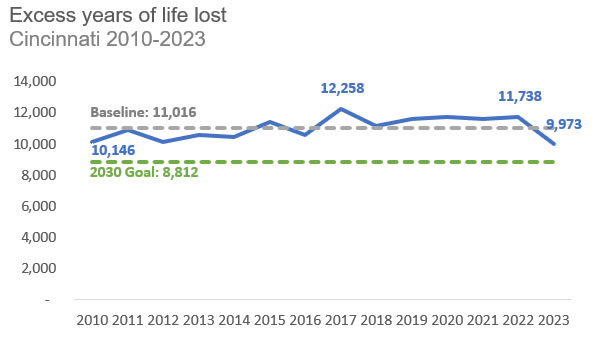Improving Life Expectancy and Reducing Life Expectancy Disparities
Our goal is to reduce excess years of life lost in Cincinnati by 20% by 2030
Cincinnati has seen a 16% increase in excess years of life lost since 2010.

Which causes of death are contributing the most?
Why is improving life expectancy important?
As leaders in public health, we want to have a healthy city that people want to live in. While the average life expectancy in the 500 largest US cities was 79.1 in 2022, it was only 75.3 in Cincinnati. In addition, Cincinnati has a 25-year neighborhood disparity in life expectancy, which is the 14th worst in the country. Reducing neighborhood disparities in life expectancy is the easiest and best way to improve overall life expectancy.
Excess years of life lost vs mortality rates
This excess years of life lost analysis allows us to directly compare reasons for reduced lifespan by neighborhood. The more premature a death is, the more significantly it affects life expectancy. Premature deaths that happen at unusually high rates in some geographic areas may be more preventable, so we measure excess years of life lost, which measures the extent to which each neighborhood exceeds the city-wide rate. Excess years of life lost addresses the “why” behind life expectancy disparities as opposed to the typically used mortality rates.
How do we reach our goal?
We can reach our goal by targeting Cincinnati neighborhoods with the highest excess years of life lost. Eliminating just the top 10 leading causes of excess years of life lost in the following neighborhoods would decrease life expectancy disparity by 12%.
Interested in learning more?
Check out our Life Expectancy in Cincinnati Dashboard
Check out the WCPO news article: Data: These are the Cincy neighborhoods with the most life years lost
HealthyNYC: New York City’s Campaign for Healthier, Longer Lives https://www.nyc.gov/site/doh/about/about-doh/healthynyc.page
City Health Dashboard: Data on over 40 measures of health and drivers of health for over 970 cities across the U.S. including life expectancy, park access, and children in poverty https://www.cityhealthdashboard.com/
Latest News
-

- Jun. 13
- Bats and Rabies
CINCINNATI HEALTH DEPARTMENT
Founded in 1826, the Cincinnati Health Department (CHD) is committed to protecting and improving the health of the people of Cincinnati. As a nationally recognized leader in public health, CHD advocates for responsive health and human services that promote healthy living environments and social wellbeing. It strives to reduce inequities such as poverty and unemployment, which often negatively impact people’s health.
CHD is a Federally Qualified Health Center (FQHC) and serves more than 45,413 patients annually. It operates six primary care health centers, offering medical, ob/gyn, pediatrics, and behavioral health. All the centers have on-site pharmacies, and five offer dental services. CHD also runs 13 full-service school-based health centers located within Cincinnati Public Schools.
These health centers, which currently serve more than 10,000 students, also serve the medical needs of children and families in the community. Five of these school-based health centers offer dental services and two offer vision services. Additionally, CHD has a free-standing dental center in Avondale.
Latest News
-

- Jun. 13
- Bats and Rabies












